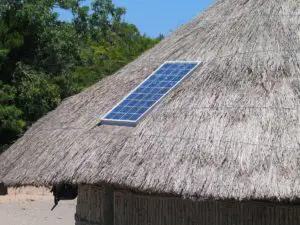Can you power a garden office with solar energy?
A simple calculation of how many watts are needed for a solar-powered shed or backyard office should let you know if solar panels can do the job of powering an off-grid garden studio. Read on for an outline of the wattage calculations needed and helpful tips on powering your backyard workspace.
It doesn’t take long after commencing working from home to see the costs begin to mount up. Spending so much more time at home puts added strain on your domestic utilities.
Keeping energy costs down for running your fully-equipped garden office makes your homeworking or business venture all the more profitable, so it is well worth looking into how you can make savings on your energy consumption.
One method of saving energy is to harness a renewable energy source like solar energy for your needs. After all, everyone can agree that sunlight is entirely free and if you install a system for capturing sunlight in your backyard, it can be used to either offset or directly power your workspace.
If your garden office or shed is off-grid, installing solar panels will make accessing energy much more convenient and may mean you aren’t so reliable on generators and batteries and the juggling and maintenance entailed.

In addition, solar energy will provide the following benefits for your workspace:
- This form of renewable energy is an almost unlimited free resource.
- Unlike a gasoline generator, solar energy is non-polluting. Generators can be noisy too.
- Solar energy is generated during times of peak usage where energy companies often charge a higher tariff.
- The solar panels can be installed right where you need them.
- Once installed, energy costs are low and day to day maintenance is easy.
Is Solar Energy Powerful Enough ?
If you are sold on proceeding with solar powering your garden office or shed, you will firstly need to ensure the system you install will be up to the task of adequately powering your workspace. After all, if you cannot power your gadgets and gear, no productive activity can take place.
To do that you will need to know the wattage needed which can be calculated in much the same way as you would if buying a generator.
Once the necessary wattage is known, you can decide if full solar power is achievable for your workspace and the number of solar panels and type of system you need.
Typical Energy Requirements For Running A Home Office.
Guestimates, as we use here are helpful but be sure to sit down with pen and paper and work everything out carefully as it would be a shame to underpower your office.
Here are wattages for typical equipment, appliances and fittings you are likely to run in your backyard home office:
| Item | Wattage (starting) | Wattage (running) | Power need |
| Computer | 600 watts | 600 watts | Continual |
| Printer | 400 watts | up to 400 watts | Occasional |
| Smartphone or Tablet | 10 watts | 10 watts | Occasional |
| Lighting (4 ceiling lights) | 240 watts | 240 watts | Continual |
| Portable electric heater or fan | 2200 watts | 1500 watts | Occasional |
| Coffee machine | 600 watts | 600 watts | Occasional |
| Lamp | 60 watts | 60 watts | Occasional |
| Router | 10 watts | 10 watts | Continual |
You can calculate the wattage required by adding up all the wattages from your equipment and appliances. In the example above the total running, wattage will be: 3420 watts.
This is the wattage required if all these items were run continually. However, if you are starting everything up from cold, you will need to consider the starting wattage for your office setup.
This reflects the power needed to overcome resistance in the circuitry of the cold, switched off devices. If everything is to be switched on at once a total starting wattage of 4120 will be required.
Of course, demand will be higher if you are operating a workshop and using power tools like welders, compressors, or circular saws.
Quick note: Don’t just add up the wattage, it is always good to consider how you will manage the power you generate. A bit of planning may mean you may get away with using fewer solar panels to power your shed. You may want to space or vary the use of items to bring down the demand for starting wattage. For example not running your coffee maker and printer simultaneously.

How Does This All Relate To Setting Up Some Solar Panels?
Once you know the total wattage you are dealing with to run your office basics you can put your mind to the solar panels needed to do the job.
Solar panels are made up of multiple photovoltaic cells that do the work of trapping the sunlight and using the energy to displace electrons, generating the current needed.
The number of panels you need will depend on the
- Energy consumption calculated in watts, and
- The number of sun hours you can expect in your region.
- The amount of energy you generate is also limited by the roof space you have available to erect the panels.
The output of a single solar panel is 250 watts per hour. For a 3kW solar power system, which may be able to directly power a functional office with everything on, 12 solar panels would need to be erected (on the basis of generating energy during 4 hours of adequate sunlight in a day).
Roof Space And Strength For Solar Panels
Each 250-watt solar panel measures 65 by 39 inches (165 by 99 centimeters) and a weight of approximately 40 pounds (18 kilograms). The roof of your garden office or main property will need to be up to the task of accommodating the surface area (which is clearly expansive for 12 panels) as well as the weight and angling of the panels.
Space on your garden office’s roof is likely to limit your off-grid ambitions
Clearly limiting what is powered via any installed solar panels will make solar energy far more viable.
For instance, running just the computer, lighting and router consumes 850 running watts which may be far more realistic as it would require only 4 solar panels spread across the roof of your garden studio.

Solar Power Installation Considerations
Installing a solar electric power supply is not as simple as erecting and wiring up a few panels. The current generated needs to be suitable for use by your devices without damaging them.
A photovoltaic or PV inverter is an essential component of a solar power system. This converter takes the direct current (DC) output from the solar panels and converts it to clean alternating current (AC) that can be used by your office equipment.
A photovoltaic system will also require surge protection. This prevents high voltage damage to the system from surge events like lightning strikes which can damage the delicate electronics in your devices. A properly working surge protection device (SPD) will provide a path to ground for excess voltage in the system.
If you are solely reliant on solar power for your office, what do you do if you want to work after sunset? If you are unable to generate solar energy for any reason you will need a backup power supply. The two main options are either a battery or a generator. Depending on the amount of solar energy generated you may be able to charge a battery which then can be used to power the office after dark. Alternatively, good quality gasoline or propane generator may be a favorable option for backup AC power.
To get the best results from your solar energy system, professional surveying and installation are recommended. Undertaking proper installation of just a few panels is still a significant investment with panels costing hundreds of dollars in addition to the wiring and hardware needed to safely power your office space.
If you are keen on a solar energy you may want to install it on your main property and benefit from add-back electricity that can offset the energy costs of running your office. In this way, you may be able to install more panels on a larger roof, and enjoy substantial savings over time. You may be able to get government grants to assist with this.
In Conclusion
Powering a garden office with solar energy appears to be the perfect set up.#
However, a simple calculation of wattage shows that the energy requirements of a working home office will require a large number of panels with the appropriate installation for the safe operation of your equipment.
Solar energy has high installation costs but it is a well-established renewable with tangible returns so it can definitely have a place in a considered energy strategy for your office and your home in general.
